| Columns Retired Columns & Blogs |
I wish they would get creative about another under $1K SACD player. "If you build it, they will come."
I used DRA Labs' MLSSA system and a calibrated DPA 4006 microphone to measure the loudspeaker's frequency response in the farfield and an Earthworks QTC-40 mike for the nearfield responses, using the Sony SA-Z1's single-ended analog inputs. I also used the Earthworks microphone to measure the Sony speaker's farfield responses with the TosLink digital input.
Looking first at the digital inputs, the TosLink optical input accepted S/PDIF data sampled at rates up to 96kHz. The USB port operated in the optimal isochronous asynchronous mode, and Apple's USB Prober identified the system as "SA-Z1" from "Sony Corporation." The Mac's AudioMIDI utility revealed that the SA-Z1's USB input accepts 16-, 24-, and 32-bit integer data sampled at all rates from 44.1kHz to 768kHz.
When I investigated the enclosure's vibrational behavior with a plastic-tape accelerometer, I found two resonant modes, one at 453Hz and the other at 1102Hz, on the top panel midway between the front baffle and the step up to the display and controls (fig.1). Only the higher-frequency mode was present on the sidewalls. Because of the low level and very high Q (Quality Factor), these modes should not affect sound quality.
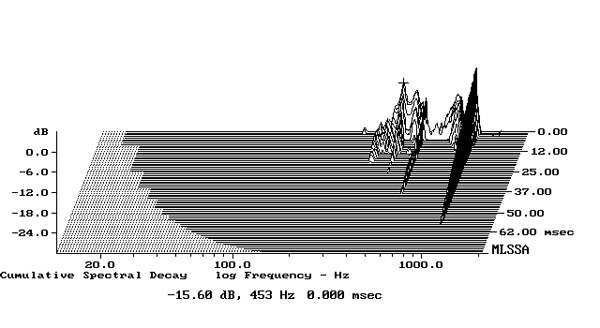
Sony's SA-Z1 system is intended to be placed on a desktop, with at least one room boundary close by. Given the arbitrary implications of this placement—How big is the desk? How far away are the walls?—I performed my usual freefield measurements with one of the speakers sitting on a high stand so that its central tweeter was 52" high, midway between the room's floor and ceiling.
With an analog signal of white noise at 500mV and the SA-Z1's volume control set to its maximum, the Sony produced a B-weighted SPL of 83.4dB at my usual 50" microphone distance. As a typical CD player's maximum input signal is 12dB higher (2V), the Sony's analog inputs have sufficient headroom for its intended use.
The Sony's farfield response, taken from the unbalanced analog input and averaged across a 30° horizontal window centered on the central tweeter axis, is shown as the green trace above 500Hz in fig.2. The tilt upward from the midrange through to the low treble is due to the freefield placement. With the reinforcement from the nearby boundaries in typical use, the SA-Z1's lower midrange and low frequencies will be boosted to better match the treble. (If it didn't have that upward tilt, the Sony would sound too warm sitting on top of a desk.) The mid- and high-treble regions are even, although, all things being equal, that peak in the presence region will be audible (footnote 1).

The blue trace below 500Hz in fig.2 shows the nearfield response of the front woofer, with its level matched to the speaker's farfield output at that frequency. The usual boost in the response in the upper bass, due to the nearfield measurement technique, is absent, and the woofer rolls off below 100Hz with a sealed-box slope of 12dB/octave. Again, the low frequencies will be extended somewhat with the expected boundary reinforcement. The red trace in fig.3 shows the nearfield response of the rear-facing woofer, which fires through the 4" high × 0.75" wide slots on the speaker's sidewalls. It reinforces the front woofer's output below 120Hz or so but rolls off above that frequency.
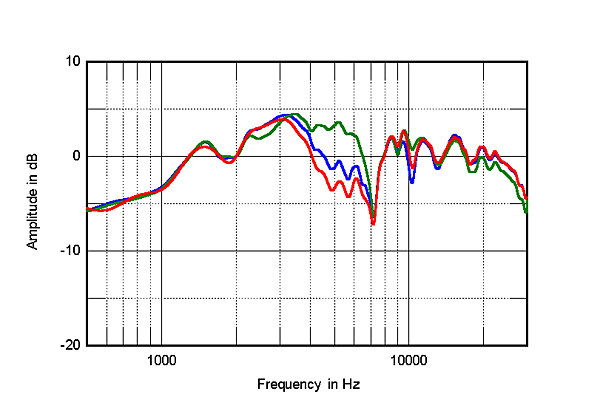
All the measurements so far were taken with the unbalanced analog inputs. The SA-Z1's DSP functions are accessible for the S/PDIF and USB digital inputs. Fig.3 shows the effect from 500Hz to 30kHz of the A.TW ALI knob set to "Sync" (blue trace), "Advance" (green), and "Delay" (red), taken with the TosLink input. (Note the expanded vertical scale in this graph.) The sharply defined suckout at 7.1kHz is consistent in all three conditions, as it was with the analog input. The "Delay" setting increases the level between 4kHz and 7kHz by up to 5dB. Conversely, the "Advance" setting depresses the same region by 2dB or so.
Figs.4 and 5 reveal the Sony's horizontal radiation pattern. The actual responses are shown in fig.4; the off-axis responses normalized to the response on the central tweeter axis, which thus appears as a straight line in the center of the graph, are shown in fig.5. Interpreting these two graphs is difficult, but the on-axis peak in the presence region does diminish to the speaker's sides, while the suckout just above 7kHz fills in to some extent. These two graphs suggest that experimenting with toe-in will optimize the SA-Z1's treble balance. The Sony's vertical dispersion is shown in fig.6, with the differences in the off-axis responses shown up to 45° above and below the response on the central tweeter axis. Despite its use of a vertical array of three tweeters, the SA-Z1 maintains its top-octave balance almost over a ±10° window. You shouldn't worry if your home-office chair places you a little above the Sony's central tweeter.
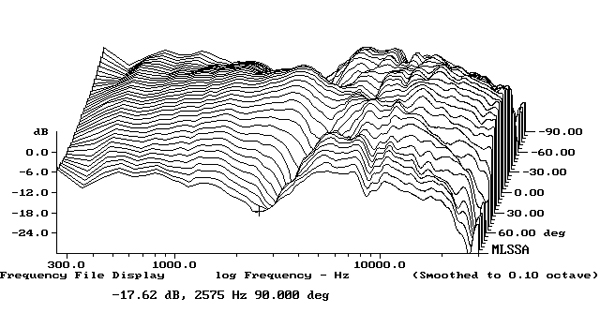
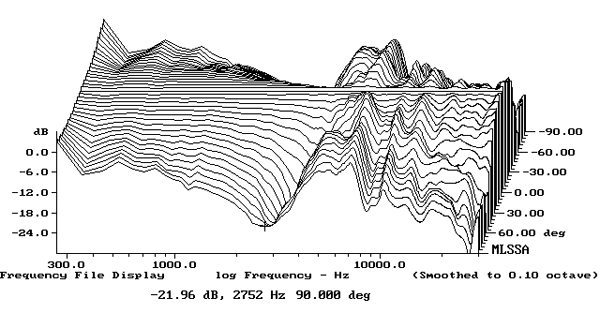
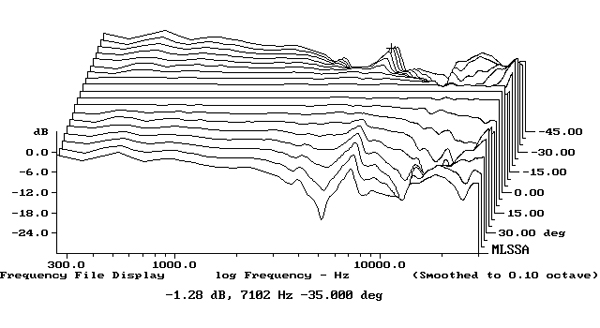
In the time domain, the Sony SA-Z1's step response on the central tweeter axis (fig.7), taken with the unbalanced analog input, indicates that all the drive-units are connected in positive acoustic polarity. Note the horizontal scale in this graph: The latency of the SA-Z1's digital circuitry means that the signal doesn't arrive at the microphone until 50.5ms rather than the usual 3.5ms (footnote 2). The tweeters' step arrives first at the microphone, followed by the woofer's step. While switching to "Delay" and "Advance" didn't change the shape of the step response for the analog inputs, with the TosLink digital input, the tweeters' output moves forward or back in time a little with the "Advance" and "Delay" settings.
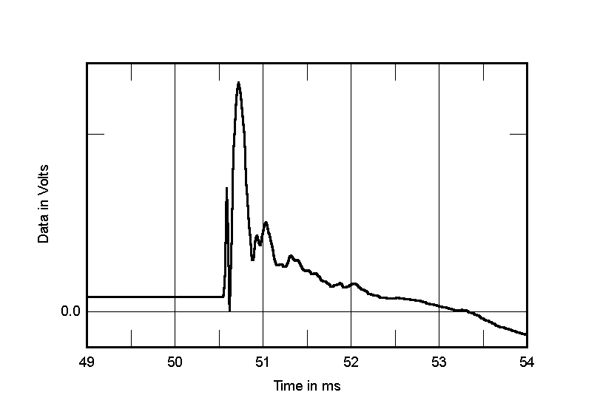
Finally, the Sony SA-Z1's cumulative spectral-decay plot, taken with the analog input (fig.8), is relatively clean in the midrange but a little hashy in the treble. The latter might be due to the use of three tweeters and the possible interference between their outputs and that of the woofer behind them. (As always with my CSD plots, ignore the small ridge just below 17kHz, which is due to interference from the computer's video card.)
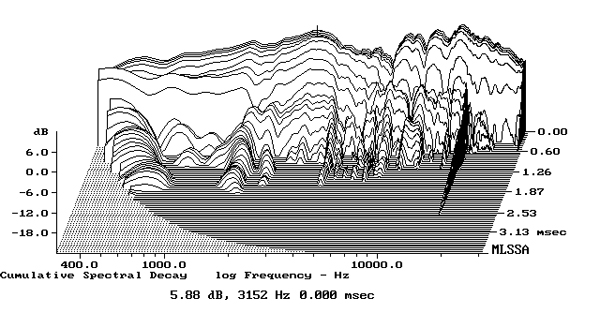
Sony has an impressive pedigree in conventional loudspeaker design (footnote 3), so I was intrigued to see how a specialized design like the SA-Z1 would perform in the test lab.—John Atkinson
Footnote 2: I average 64 individual captures to calculate a loudspeaker's step response in order to minimize the effect of ambient noise. Nevertheless, the apparent DC offset in this graph is due to the build up of low-frequency noise during the very long time window used for this measurement.
Footnote 3: See, for example, my September 2013 review of the Sony SS-NA2ES.

I wish they would get creative about another under $1K SACD player. "If you build it, they will come."

You can extract the DSD layer from SACDs and store that data on an inexpensive network attached server (Kal knows how to do this).

JVS is very excited at the performance of these $8K desktop speakers, although he's clearly puzzled that Sony doesn't use power conditioners in their labs. (Fortunately, Mr. Carlsson doesn't disabuse him of the benefits of power cords and cables.)
Meanwhile, from deep in the recesses of the audiophile equivalent of the Federal Reserve, JA1 provides his perspective in plain language that's accessible to longtime readers of his valuable measurements:
Sony has an impressive pedigree in conventional loudspeaker design (footnote 3), so I was intrigued to see how a specialized design like the SA-Z1 would perform in the test lab.

... not made in JAPAN ?
Who is the intended customer for these things ?
Did SONY see a pair of Devialet Phantoms and decide to compete by making something in Malaysia selling at 2 to 4 times the price with a two year warrantee but no beautifully designed packaging?
The SONY Brand is no longer 2D4, besides these things are ugly. ( doncha think ? )
Will our wonderful whistler be keeping these Demo's for extended evaluations ?
Tony in Venice Florida
ps. frequency range : 10hz to 200khz ---- 200,000 hz -- wow, it's almost RF. is this a Class D rig with large heatsinks ?

Some radio transmission frequencies can also get pretty low. The ITU designates "ELF, extremely low frequency" band of radio frequencies as 3_Hz to 30_Hz. While the low bandwidth forces slow transmission of information, the extremely low frequencies are capable of penetrating ground and sea water.
https://physics.info/em-spectrum/

Ok, thanks, I might've been attempting a bit of exaggeration concerning the propensity of Japanese to exaggerate dubious performance properties.
It might seem appropriate for an $8,000 Asian desktop device to have a bit more bragging rights than a modest Genelec Active 820 system costing about $1,000.
Thanks for writing back with a bit of science related to wave propagation, it's nice to know that proper Scientists read Stereophile too!
Tony in Venice Florida

Hi
Good question! Who really wants to drop $8,000 for a pair of desktop loudspeakers !?
Only some very few rich & famous would want to put those not-so-handsome
looking loudspeakers on their desks assuming they were sound crazy like some of us !
There are far smarter & less costly way to enjoy music on one's workdesk. Why $8,000 made-in-Malaysia Sony? Where would Sony stand on the really Hi-end audio wagon anyway ?
Jack l

Thanks for writing back,
Who is the intended ? Maybe these things are designed for some industrial build application like the ceiling of a Bus or the interior of a small Corporate Jet.
It's puzzling !
Tony in Venice Florida

For anyone who would like a deep soundstage on their desktop at a lower price, I can enthusiastically recommend the Buchardt Audio S300 speaker. Provided you can accommodate its larger size, it's ideal. It has a very even off-axis response, which gives you a wide (and deep) sweet spot as you move around while working at your desk. I find its sound comparable to the Dynaudio Special 40. The Special 40 is slightly better at resolving midrange textural detail, but the Buchardt has a more even response (especially off-axis), and sounds a little more open, with equally good bass weight. I have no connection with Buchardt Audio; I just really enjoy these speakers whenever I listen.

I have certainly enjoyed my pair of 305's for way less money for years now.

... have something completely different?
Start with a pair of LS3/5a-esque near-field monitors.
Take your pick from Graham, Harbeth, Spendor, Stirling, etc.
Add a tube-type integrated amp - the PrimaLuna EVO 100, for example.
Complete the system with a DAC, such as the Chord Qutest or the Schiit Yggdrasil.
For a similar total cost, have JVS see (and hear) how such a combo might measure up - in a manner of speaking.

I hope to see a review by John Atkinson of the KEF KC62 subwoofer used with the LS50 Metas. It would be interesting to see how this combination handles the bass on the Seattle Symphony's Also Sprach Zarathustra.
I would also like to see Mr. Serinus review this recording:
https://bachtrack.com/review-honeck-beethoven-leshnoff-pittsburgh-symphony-june-2019
https://referencerecordings.com/recording/beethoven-symphony-no-9/

not by me. By the time I asked about reviewing it, it had already been claimed. So I chose other goodies. Stay tuned...
jason

Thanks for the preview of coming attractions.

......... Also Sprach Zarathustra."quoted C E Flynn
Why should I spend $3,000 for these 3 KEFs minis to play Also Sprach on my workbench ASSUMING these minis could make miracles on tabletop environment.
For serious music performances as such, I would definitely play them properly on my audio rig - no less ! We should show some respect to its composer: Richard Strass !
I've 4 or 5 LPs on the Also Aprach title & the best 2 out of those are the DGG label: Karajan conducting the Berlin Philharmonic. Only one of these two sounds to my satisfaction: starting with some clean deep deep low crawling bass notes followed immediately by the CLEAN & powerful beating of the kettle drums !!!
An acid test of transient response of any sound system: clean low low crawling bass notes, IMMEDIATElY followed by CLEAN & forceful kettle drums beating of Also Aprach Zarathustra on LP.
Listening is believing
Jack L

if they weren't so boxy. Sony's industrial design is usually as good as Apple's, but these speakers are not in that vein.

RAAL Requisite SR1a ribbon headspeakers and Schiit Jotunheim R amplifier (the set, $4.0k from Moon) in combination with an Okto Research Dac8 Pro (sub-$1.2k direct) and a pair of SVS SB16 Ultra powered subwoofers ($2.0k/each, $3.8k/pair, direct), and the alternative system comes in at a little under $8k. Everything mentioned has been reviewed here at Stereophile in the not too distant past (oldest being the subwoofer back in 2017).
The use of headphones or headspeakers avoids the myriad of issues with interference from reflections from objects on and near the desk and nearby room boundaries, as well as interference from diffraction around edges of those objects.
The RAAL ribbon headspeakers are at or near the top of the headphone game, the weaker aspects being lack of isolation and limited low frequency output. The lack of isolation is a problem that is also shared with loudspeaker setups. The limited low frequency output can be solved with use of subwoofers. The subwoofers could also be utilized to augment a loudspeaker setup, when not using headspeakers/headphones.
SVS SB16 Ultra is a low distortion powered sub capable of high volume velocity on wide bandwidth (for a sub) from a sealed alignment exhibiting much lower group delay relative to bass reflex, and includes significantly capable DSP.
If applying separate upstream DSP to the RAAL headspeakers, the subs could receive a separately processed or unprocessed stream through the Okto 8 channel DA converter while the Okto also provides a master multichannel volume control.
That leaves four channels on the Okto which could be utilized to feed another pair of power amplifiers and loudspeakers plus another different headphone amplifier and headphones. Or the four channels could be used to integrate a pair of small satellite monitors (eg. KEF LS50 Meta) with a pair of bespoke woofer bins (maybe talk to Lee Taylor or Jim Salk about what they can build for you) either some side firing midwoofers located behind the computer monitor if used with desktop monitor loudspeakers, or some woofers in bass bins used as floor stands for your stand mounted monitors setup elsewhere in the room.
The Okto multichannel DA converter with multichannel volume control, especially in combination with upstream DSP and/or external AD converters, enables much system flexibility.

....... with interference from reflections...." quoted JRT
Maybe so in theory. I don't experience such "interference from reflection" in my 700sq ft basement audio den withOUT any elaborated acoustic treatment at all !
So yr acoustics 'science' can't blind my critical ears !
BUT, headphones or headspeakers FAIL to deliver the same live 3-D spartial environment offered by any floor/stand loudspeaker. You may not worry about it but many live concert goers, like yours truly. do !
That's why I personally do not go for any headphone music !
You know why? Hint: this is the nature of our ears BOTH sharing the same soundwaves !
Listening is believing
Jack L